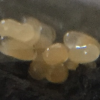Leave her alone. Of course she'll be scared when she's supposed to underground in the dark and all of the sudden we take a peek and now there's light, movements, and vibrations. All of the Pogonomyrmex queens I have do that too when I look at them. It looks like Pogonomyrmex is especially jumpy though. My Pheidole and Forelius don't care all that much when I pick up their tubes and look at them in the light. Even my Myrmecocystus can be observed with a flashlight without them panicking all that much. Though my Dorymyrmex insanus are also a bit jumpy, but not as much as the Pogonomyrmex.
My P. subnitidus did great in a test tube placed in an out-world. She was caught on July 6, 2017 and she's up to 15 workers now. This year I had successful P. rugosus founding in a water bottle, medicine bottle, small snap cap container, and test tubes. They seem like a pretty easy species to found and they don't seem picky at all from my experience. As far as diet goes Pogonomyrmex eat seeds almost exclusively. I read somewhere about 98% of their diet is seeds with the other 2% as insects.
This is my first year ant keeping so I'm not that experienced yet but I seem to have passed the founding stage fairly easily for this genus. For the next part, the formicarium stage, you'll need to give them a dark dry area to store their seeds. They're called Harvester Ants for a reason. They'll stock pile seeds in dedicated chambers of their nest, usually at the top where it's dry.















